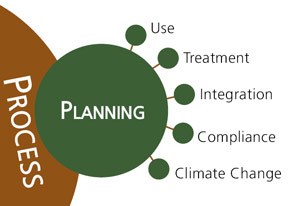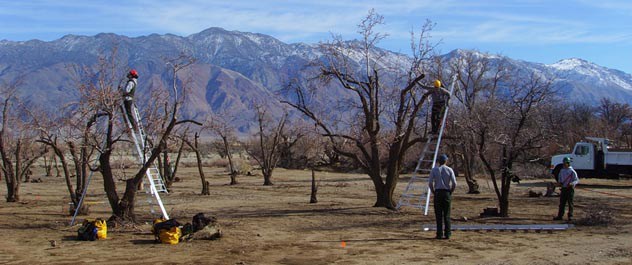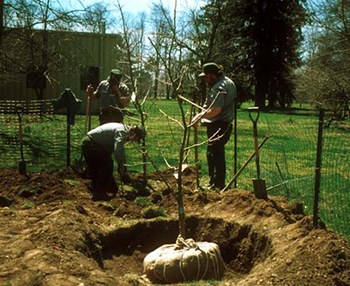
NPS Photo
Cultural Landscapes and NPS Park Planning
Cultural landscape issues, such as historic land uses and the location and character of significant resources, are considered in the development of all park plans to avoid adverse effects on cultural landscapes. A park's general management plan or foundation document is guided by information in the Cultural Landscapes Inventory.
Development concept plans are coordinated with the preparation of a Cultural Landscape Report, and they may involve a historical landscape architect to ensure that future development retains the significant characteristics and features of the landscape.
In all park plans, the planning process is a fundamental tool for integrating information and determining relationships among cultural landscapes and other resource types.
Decisions About Treatment
Information about the significance, integrity, and condition of cultural landscapes is necessary for making planning decisions about treatment. It is also required in many activities associated with future management and preservation maintenance. The Cultural Landscape Report is the primary planning document for the treatment of cultural landscapes.

The NPS Cultural Landscapes Program follows these standards:
- The Cultural Landscapes Inventory, generally Part I of a CLR, is completed before any major park planning effort is undertaken that has the potential to affect a cultural landscape.
- Proposals for actions affecting a cultural landscape are consistent throughout all the park's plans.
- Development plans affecting a cultural landscape involve consultation among historical landscape architects and other resource specialists to assure appropriate protection of all resources.
Cultural Landscape Report Contents
Introduction
The introduction includes five sub-sections:
- a management summary describing the purpose of the project;
- a historical overview that provides a brief historical context for the landscape;
- a description of the scope of the project and methodology for completing it;
- a description of study boundaries; and
- a summary of findings.
PART 1: Site History, Existing Conditions, Analysis, and Evaluation
Site History
This section provides a historical description of the landscape and all significant characteristics. The text is based on research and historical documentation, with enough support material to illustrate the physical character, attributes, features, and materials that contribute to the significance of the landscape. This section identifies the historical context within which the landscape developed, and the period or periods of significance if this has not been done in the HRS or National Register nomination.

Camp Curry Historic District Cultural Landscape Report, Yosemite National Park Research Library
Existing Conditions
This section contains a description of the landscape as it exists today including the documentation of landscape characteristics such as land use, vegetation, circulation, and structures. It is based on both research and site survey, including on-the-ground observation and recordation of significant features. A condition assessment is completed to determine the age, material, composition, and integrity of significant components.

NPS
PART 2: Treatment
This section describes the preservation strategy for long-term management of the cultural landscape based on its significance, existing condition, and use. It also includes a discussion of overall management objectives for the site as documented in planning studies or other management documents. The treatment section may address the entire landscape, a portion, or a specific feature within it. Treatment is described in a narrative text, treatment plan, or design alternatives.
PART 3: Record of Treatment
This section summarizes (a) the intent of the work, (b) the way in which the work was approached and accomplished, (c) the time required to do the work, and (d) the cost of the work.This section also contains copies of the field reports, condition assessments, and contract summaries. It is usually included as an appendix or addendum to the CLR.
Appendix, Bibliography, and Index
This section contains supplemental drawings, illustrations, maps, photographs, technical information, or other support documentation. It also contains a list of sources used in preparing the document and references to material in the document.

NPS Photo, 2014
- A CLR is prepared to minimize loss of significant characteristics, features, and materials when existing information about the physical history and condition of a cultural landscape is inadequate to address anticipated management objectives, when impending development alternatives could have adverse effects, or to record actual treatment.
- The CLR is prepared by qualified professionals based on appropriate methodologies and techniques for cultural landscape research, documentation, and evaluation.
- Archeological records, base maps, and techniques such as soil analysis are used for data on non-extant or archeological features and conditions.
- Landscape, architectural, and archeological investigations supporting a CLR employ nondestructive methods to the maximum extent possible; they are prescribed and justified in a task directive that includes a research design and impact analysis.
- Confidential information on the location, nature, character, or ownership of archeological and ethnographic resources is identified as confidential and not made available to the public.
- National Register documentation is prepared or amended to address cultural landscape resources identified in a CLR after its preparation, if appropriate.
- All field notes, primary documents, original maps, drawings, photographs, and plant materials gathered or associated with the research for CLRs or special landscape projects are organized and preserved as archival material or museum objects.
- Reprint and web-display permission is obtained for any copyrighted creative works included in the document, including non-NPS photographs, maps and drawings.
- All information regarding the condition and preservation maintenance needs of landscape characteristics and features is incorporated into the Facility Management Software System (FMSS).
Compliance
In order to comply with National Historic Preservation Act (NHPA) Section 106 and National Environmental Policy Act (NEPA), particular attention is given to identifying and evaluating cultural landscapes and their significant landscape characteristics, features, and uses so that the effects of proposed undertakings are adequately considered. Through the planning and compliance process, adverse effects are avoided, minimized, or mitigated.
Under the 2008 NPS Servicewide Programmatic Agreement for Section 106, actions affecting cultural landscapes, thus requiring Section 106 compliance, fall into two categories: "Streamlined Activities with Streamlined Review" and "Standard Activities with Standard Review."

NPS
Streamlined Activities
Streamlined Activities are routine actions in the preservation maintenance and repair of cultural landscapes and Streamlined Review involves a team of cultural resource (CR) reviewers, rather than the state historic preservation office (SHPO), to complete the assessment of effect for Section 106.Streamlined review can be used when cultural resources have already been completely identified with concurrence from the SHPO (such as in a certified CLI). Streamlined activities include grass replanting, routine lawn maintenance, woodland management, the maintenance of historic vegetation, roadside and trail maintenance (with no ground disturbance), resurfacing of roads and trails (with no ground disturbance), removal of dead or downed vegetation (with no ground disturbance), and the replacement of vegetation with the same species in the same location.
While the activities in the Streamlined Review category can have expedited review, routine actions such as pruning and replacing vegetation, mowing grass, repairing fences, resetting and replacing paving materials in kind, and maintaining roads, paths, and trails have the potential to profoundly affect the character and integrity of a landscape over time.
Although the work required to maintain a cultural landscape may not differ significantly from other park maintenance practices, many landscapes require special attention and knowledge in the care of various features. The CR team providing Streamlined Review must understand the cultural resource values of the cultural landscape, and the management objectives for preservation maintenance.

NPS Photo
Standard Activities
Standard Activities are rehabilitation actions that go beyond maintenance or repair, or are actions undertaken for management purposes other than the preservation of a cultural landscape. Standard Review involves consultation with the SHPO, and first requires the identification of cultural resources within the Area of Potential Effect, possibly requiring the completion of a CLI. Actions in this category can have significant adverse effects on a cultural landscape if not planned and carried out with consideration of its values.
Examples include the construction of buildings and general work associated with site development; the addition or resurfacing of trails to meet accessibility standards; the addition of contemporary patios, fences, walkways, walls, utilities, and site furniture; and changes in use from open space to parking lot, visitor center, or maintenance yard. Although the impact of a single such action may be minor, the cumulative effect of successive actions may be adverse.
The NPS Cultural Landscapes Program follows these standards for actions affecting cultural landscapes:
-
A landscape is evaluated for National Register eligibility before or during a Section 106 consideration of an undertaking that could potentially affect the landscape.
-
Proposed actions are evaluated for their effects on individual landscape characteristics and features and landscapes as a whole.
-
Any ground disturbance in a cultural landscape requiring archeological clearance is reviewed in advance by a historical landscape architect in consultation with an archeologist.
Use
Use is an integral characteristic of a cultural landscape and impacts the landscape both materially and spatially. In vernacular and ethnographic landscapes, significant patterns of land use may have varied over several generations, while in a historic designed landscape land use activities may be fixed. Contemporary use of a cultural landscape is appropriate (1) if it does not adversely affect significant landscape features, and (2) if it either follows the historic use or does not impede public appreciation.
Last updated: August 26, 2025

